Over a year before the preliminary field test program ended, the Planning Conference recognised the need for a study on the nature,extent, and requirements for the final system tests. These tests represented the greatest single jump in complexity during the whole course of the program, because the entire system loop was to be closed for the first time. In addition, many auxiliary facilities were required to implement the test. More generally, it was necessary to determine what the system tests should discover and how this discovery could best be made with only a limited number of test vehicles. Accordingly, a System Test Committee was appointed, which drew up a series of plans for the system tests. In such a complicated endeavor, it was not to be supposed that these plans could be adhered to in absolute detail; however, they were followed rather closely and served as a guide throughout the program.
As a result of this continued planning effort, the project found itself in the fall of 1951 with a system which had been fully component-tested in the field, with the additional systems componentsand gear ready and completely laboratory tested, the test equipmentand instrumentation readied for use, and the test plans already laid.
To implement the procedure set forth in the test plans, it was necessary to have, first, a target through which the system loop could be closed; second, a carefully designed net of instrumentation capable of furnishing all the data required; and finally, suitable test-firing circuits for coordinating all elements of the over all test system.
When the Target-Computer-Missile control loop was to be closed for the first time, the most cautious procedure conceivable would have called for establishing a motionless target sufficiently high above the ground to insure a clear radar localization unhampered by ground reflection influences. Artificial radar targets carried by tethered balloons or slowly falling and drifting parachutes were consideredbut later abandoned as involving undesirable operationalcomplications. Several of the planning conferences occupied themselves with many details of the entire test target problem. The value or significance of "proving" the NIKE system loop against a space-fixed target prior to its extensive tests against flying targets was extolled by some and disputed by others.
It was realised that the terminal phase of tracking a missile towards a ground target would be disturbed by ground reflections.[page 103]
Therefore, no ground target shots could be regarded as truly representative of the situation prevailing in the "end game" against an airborne target. Eventually the controversy was resolved by a compromise decision to fire the first and at least one more missile towards a fixed ground target located by a topographical survey, with the missile steering orders zeroed at two seconds before impact so that spurious orders would be avoided.
To implement this plan,a two-panel corner reflector, about sixteen feet high, was set up on a slight rise of ground at a point about seven degrees west and 31,000 yards north of the NIKE radar station site. The reflector could be seen by the radar so that the radar sight angles could be statically checked against the topographical survey, and they agreed within a fraction of an angular mil and a few yards. However, there remained dynamic perturbations due to ground effects. To avoid them in the ground target firing tests, the target position data were fed to the computer in the form of known survey coordinates rather than by locking on the reflector, the main purpose being to verify the proper functioning of the missile tracking and guidance system and to demonstrate that the entire apparatus was now ready to take on flying targets.
The necessity of testing the NIKE system against flying aircraft targets was recognised in the beginning of the project. As far back as the September 1948 Planning Conference, a proposal to fire a number of test missiles at live aircraft as flying targets was accepted as an indispensable partial objective of the NIKE system tests. The chance of an incapacitating hit, even without combat warhead, was deemed too great a risk to consider firing at a manned aircraft. Hence, unmanned, remotely-controlled drones had to be adopted despite their complications, cost and operational limitations.
Since the NIKE system was designed to combat bombers of the future, at the time of the system tests no aircraft of typical target performance was yet available, much less a remotely controllable drone capable of serving as a target. A study of the relative merits and short comings of various types of target drones in service led to the compromise choice of two types of targets. One was the QB-17G drone modification of the Flying Fortress bomber, which would be representative in size but deficient in speed, altitude and maneuverability; and the other was the QF-80 drone version of the Shooting Star fighter, which would come closer to the desired target speed range, though it was too small to represent a typical bomber and still deficient in altitude capability. An effort was made to obtain both types of drones, but the fighter type (QF-80) did not actually become available in time for the system tests. (QF-80 drones did become available shortly afterward and were successfully used as targets in a number of NIKE I firings.) Hence, all aerial target firing had to be directed against QB-17 aircraft, which served their purpose most capably though within the limitations dictated by their speed, range, ceiling, and maneuverability. Even so, the adaptation of QB-17 drones turned out to be a major effort, requiring them to be equipped with improved autopilots, with automatic maneuvering programmers, with additional radio gear, and with specially developed photographic scoring cameras. These preparations were completed between 1950 and the fall of 1951.
During the course of the earlier field firings, a great number ofinstrumentation facilities had been built up, many of them associated with regular Proving Ground activities. Among these were the Bowen-Knapp camera which followed the boost and separation phases ofthe trajectory; the Askania and Mitchell phototheodolites which had long furnished the project with its basic trajectory data; the various high-power telescopic cameras which had proved of great value in analysing trouble conditions; and the various telemetry stations. In addition to these sources, however, it was necessary to introduce other instruments especially adapted to the rather rigorous requirements of the system tests.
The instruments used in these tests had to fulfill a number of overlapping but distinct functions. One basic function was to provide in each round a determination of the miss - not only the vector miss distance at burst, but also an adequate knowledge of the relative trajectory of the missile and drone in the neighborhood ofintercept. Another function of the instrumentation net was to allow a detailed and quantitative analysis of successful rounds, so that the contributions of the major system components and the balances among them might be accurately appraised. In the event of rounds less than wholly successful, it was necessary to be able to trace down the design features which were at fault and to determine the nature of needed improvements. Finally, in the case of malfunctioning rounds, the instrumentation had to be of a sufficiently fine mesh to allow quick isolation of the cause of the failure. To fulfill the functions outlined above, a correspondingly elaborate set of instruments was required. The terminal portion of the trajectory where great accuracy was demanded was derived mainly from the ground-based IGOR (Intercept Ground-Station Optical Recorder) camera system and from the drone-borne ITOR (Intercept Target Optical Recorder) camera system. Both of these systems were capable of meeting the ten-foot accuracy requirement on the point of burst, which was tokened by the detonation of a spotting charge in the missile. In addition, to the extremely accurate account of the end game, reasonably precise trajectory data on both missile and drone were required throughout the flight. Here, major reliance was placed on the phototheodolites, on the boresight cameras attached to the tracking radars, on plotting board data derived from radar measurements, and on the continually photographed records of the computer dials which repeated the radar position data. The ability to analyze completely the performance of a given round required, in addition, a knowledge of what was going on inside the missile. Accordingly, all of the rounds, except for five with live warheads, carried telemetry sets which gave a continuous record throughout the flight of the various functions associated with propulsion, guidance,and control.
There remained the problem of ground guidance equipment consisting essentially of the two radars and the computer. The operation of the radars could be reconstructed from three sources of data. The first of these was the continuous photographic record obtained through telescopes attached to and boresighted with the radars. The second was the photographic records of the computer dials which followed the radar position inputs to the computer. The third was the account ofthe internal functioning of the radars as recorded on eighteen channels of pen oscillograph recording all the important functions, not only of the radars themselves but also of the communication link from the missile radar to the missile. Accurate monitoring of the beacon responses and the computer orders transmitted by the radar was possible by such instrumentation
The many complex functions performed in the computer were recorded in several ways. An oscillograph pen recorder ("events recorder") gave an account of various discrete events in the course of the flight, such as the end of the turn phase and the initiation of the burst. In addition, eighteen pen channels gave information sufficiently detailed so that computer operation throughout the flight could be completely reconstructed.
A completely instrumented system of this complexity, involving many agencies with personnel at many locations over the Proving Ground range, demanded excellent coordination at the time of firing to assure that the target, instrumentation, and and system proper were ready for the test firing. The system test firing circuits were therefore organised in such a way that the overall system was broken down into a number of well-defined areas of responsibility. The Project Commander, who directed the operation and actually ordered the missile to be fired, had reporting to him three control officers, each of whom was responsible for bringing his section of equipment or instruments to readiness prior to firing.. One of these sections comprised the radars and the computer; another the missile operation;and the third the drone operation, range safety, and range instrumentation. Each position in the firing organization was provided with visual indication of events only in its immediate sphere of interest. The system was designed to provide adequate communication by means of telephone circuits and lamps between the Project Commander and his auxiliary officers, and between each of them and the units under their control. Inter-locking firing circuits were designed so that, unless all stations were ready, the fire order could not be transmitted.
This arrangement proved to be entirely satisfactory, and a great deal of valuable experience was gained (which benefited the eventual design of the NIKE I fire-control equipment).
As stated earlier, the NIKE R&D System was designed specifically for test purposes, with provision for instrumentation and observation wherever possible. It was neither a quantity production design nor a fully tactical equipment, the latter objective being the goal of the NIKE I version which was getting on to its stride concurrently. Convincing as they were, the system tests did not and could not prove or explore the performance boundaries of NIKE, chiefly because of the speed and altitude limitations of the available target drones. Though restricted in number to less than any fair statistically representative sample, they covered the central part of the speed, altitude and maneuvering range for the whole gamut of approach aspects with such good results that modest extrapolation of lethality to somewhat larger ranges than tested seemed obviously justified. To what extent unexpected phenomena might be encountered at extremes of altitude or other parameters remained to be experienced or explored on future occasions. On the other hand, at the long-range moderate end of a coasting flight, previous tests had already shown the missile to be controllable in the transonic and subsonic areas down to much lower speeds than had been assumed at the time of the AAGM report.
In the course of the initial R&D System Test firing program, twenty-three rounds were fired. These tests, of course, were only the beginning, since firings continued with the tactical NIKE I missile after the R&D rounds were expended. The results here,however, are confined to those rounds fired during the first system demonstration, Naturally, no single event or test shot was intendedto be representative of anything like the "proof of the pudding". Indeed, even the whole of the system test with its various facets could do no more than convey a picture of the results of some six years R&D effort, the ultimate objective of which was to demonstrate the feasibility of a command-guided missile system.
General information on the circumstances and results of the 23 test rounds is given in the accompanying table, entitled "Summary ofSystem Test Rounds."1 In examining this summary sheet, it becomes evident that the rounds to be discussed fall into three sharply definable categories. Category 1 includes those rounds for which there was no evidence of malfunction either in the ground equipment or the missile-borne gear. In Category 2 belong those rounds for which some known malfunction existed, the deficiencies of which were directly and definitely traceable to this malfunction. Category 3 comprises those rounds that were unsuccessful, as far as the system was concerned, because of some missile component failure. Of these three categories, Category 1 is of the greatest significance and will be discussed first.
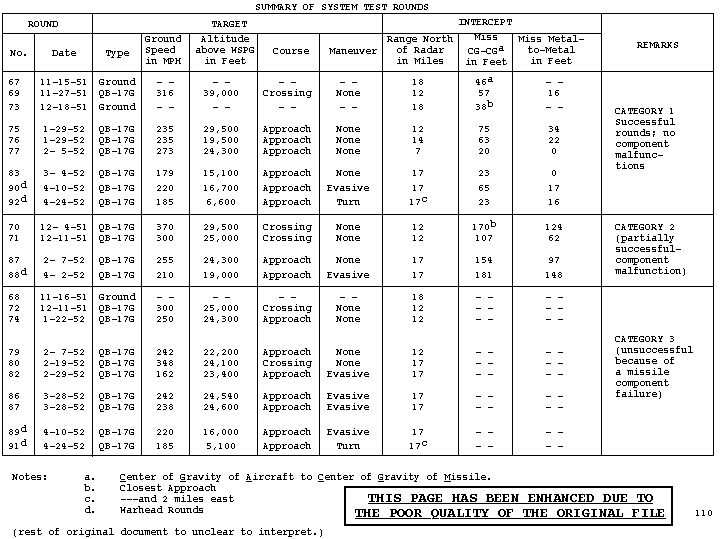
The rounds of category 1 divide into two groups-two rounds (67 and73) fired at a ground target, and seven rounds fired at aerial drones.
The first firing at the ground target occurred at WSPG on 15 November 1951. It was a high point in the history of the NIKE system, marking the first time - six years after the inception of theproject -that the NIKE system loop was closed in the field. The result of this 18-mile firing was completely successful with the missile passing at a distance of 46 feet from the corner reflector at the ground target. (An analysis of the test data furnished assurance that the system was ready to take to the air. Consequently, several rounds were fired against aerial drones before returning to the attack of a ground target.) The second ground-target firing (round 73) on 18 December 1951 was equally successful, with the missile passing 38 feet from the corner reflector. In both these ground-target firings, large variations in the elevation position of the missile occurred shortly before intercept, as had been expected.2 These variations resulted from ground reflections at low-elevation angles. Partly on their account and partly to insure a spotting charge detonation above ground, the time of the burst with respect to intercept had been advanced in the computer. Accordingly, valid burst time were not determined for these rounds, and the miss figures shown in the foregoing table are those of the closest approach of the missile course to the target.
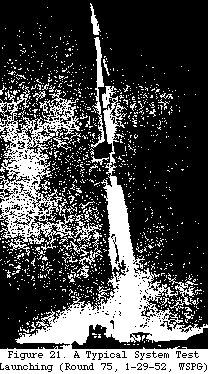
The first firing of a NIKE at an airborne target took place on 27 November 1951, when Round 69 was fired. It was an immediate success; the missile token burst appeared 57 feet from the centre of the drone flying a crossing path at a 12-mile range and 33,000 feet above sea level (see Figure 22, Page 113). This event represented a significant milestone, not only in NIKE history, but also in asomewhat broader sense, in that it marked the first successfulengagement of an air-target by an antiaircraft command-guided missilesystem. (The subsequent 20 tests were accomplished in fairly rapid succession and concluded within five months thereafter)
Other Category 1 rounds dispatched against airborne targets were Rounds 75, 76, 77, 83, 90, and 92. Although this summary sheet givesthe basic information pertaining to these rounds, it does not tellthe complete story in some instances. In the case of Round 77, forexample, the burst miss distance figure of 20 feet obscures the factthat the missile actually struck the tail assembly of the drone andcaused serious damage. Similarly, in Round 83, where a burst missdistance of 23 feet is listed, it is important
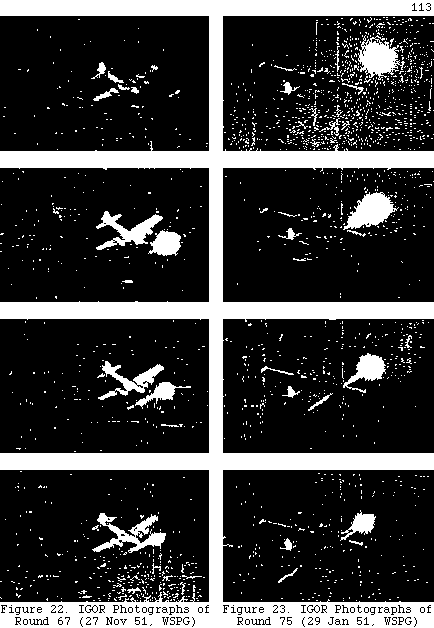
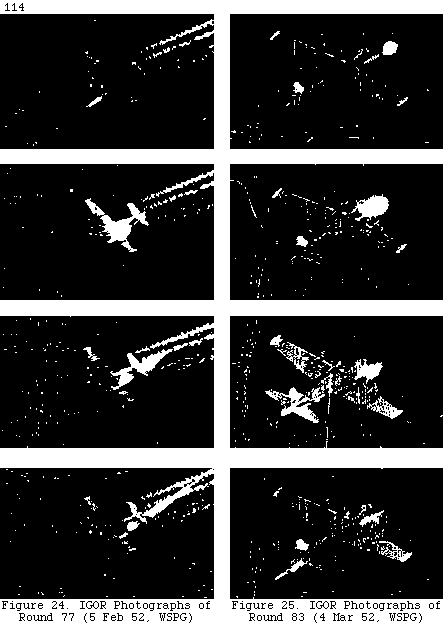
IGOR photographs of Rounds 69, 75, 77 and 83 are shown in Figures 22 through 25. These pictures are samples of photographic coverage of the intercept phase by the IGOR system of ground-based high-speed long-focus cameras developed by BRL for the purpose of insuring a pictorial record of intercept even if the drone was destroyed and ITOR films were lost. (Rounds 90 and 92 are discussed separately under "Live Warhead Firings.")
An examination of the overall results of rounds in Category 1 reveals two basically important facts. First, the miss distances vere all adequately small in the sense that the missile at burst was, in every case, generously within lethal range of the target. The second point of importance is that the command fusing appeared to be very accurate indeed. As a matter of fact, there appeared to be little likelyhood that its quality could be improved or even met by the use of influence devices.
In round 88, the warhead burst occurred about 81 feet below the belly of the plane and a little to one side. In spite of this large miss distance, however, the bottom of wings and fuselage were punctured with about 170 fragment holes, a large number of which continued on through the aircraft. The damage was such that personnel would have been killed or wounded - in particular the bombardier probably killed - and hydraulic lines were severed. The Air Force assessor, who was present at the firings, was unable to definitely classify the formal category of damage; however, the available evidence pointed to a "C" kill, which is taken here to mean the inability of the plane or its crew to complete a successful mission. Actually, the plane was eventually landed by remote control.
Rounds 90 and 92 were quite similar in their effects. Round 90 had a moderate CG to CG miss of 65 feet, while Round 92 represented a close miss of 23 feet. Both produced immediate destruction of the aircraft ("K" kill) as illustrated in Figures 26 and 27.
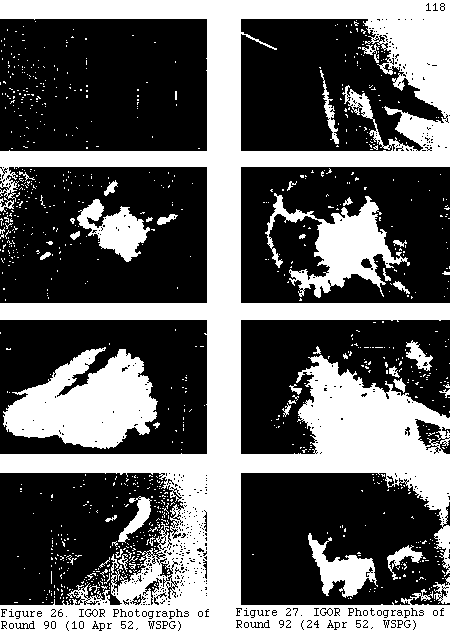
These two firings represented another dramatic milestone in NIKE history, in that they fully demonstrated the power of NIKE as a destructive antiaircraft weapon, thus marking the culmination of the R&D program. Of equal significance is the fact that these firings were witnessed by a number of high-ranking Army, Navy, andAir Force officials. While Rounds 90 and 92 were spectacular and reassuring shots, little can be said concerning the mechanisms of the damage. The crews would have been wiped out (with the possible exception of the tail gunners); fuel fires were set; holes were bored through the propellers; and the structures first weakened by fragments were deformed by blast and gust. To a considerable extent,the wreckage was molten and dispersed. While the above facts may be fairly summarised from the remains, little else can be said.
No statistical facts could be gleaned from these few firings;however, it was the general consensus of opinion that the time and expense involved were eminently justified. They gave to the design and the user a sense of the power of the weapon for its task that could have been obtained in no other way.
In appraising the overall results of the formal R&D system demonstration just described, the reader should bear in mind that the primary objective of the program up to this point was to prove in the field that a physical system similar to that proposed in the original AAGM Report would perform as envisioned and would, in fact, meet the specifications imposed on it. Therefore, the system test missile employed research and development equipment designed only to demonstrate the feasibility of the NIKE command-guided missile system.
For all intents and purposes, then, the overall NIKE R&D System demonstration could be considered a complete success, despite the fact that only a little over 50% reliability was attained even when firing under optimum test conditions. While it was apparentthat a considerable amount of engineering effort would still be required to produce an acceptably reliable NIKE Missile and control system, the R&D System Tests proved by a generous margin that the original specifications could indeed be met and, in many respects, could clearly be exceeded. Moreover, these tests yielded invaluable experimental data on several scientific problems of controlling importance that had been the subject of much theoretical debate for anumber of years. Among these was the basic problem of obtaining sufficient radar, computer, and missile response accuracy to make a command system effective up to the ranges contemplated for NIKE I
Even though the R&D System was neither required nor designed to be a tactical weapon as such, tactical requirements were adhered to as closely as sound scientific evaluation of the system would permit. Consequently, a minimum of change was required in the accelerated development of the first tactical guided missile system which was to become the NIKE I.
1. PROJECT NIKE SYSTEM TEST REPORT, BTL & DAC, 1 September1953.
2. PROJECT NIKE HISTORY OF DEVELOPMENT, BTL & DAC, 1 April1954.
3. PROJECT NIKE ARMY ORDNANCE TECHNICAL LIAISON REPORTS, by LtColonel Robert E. LeRoy, ResidentArmy Ordnance Officer;
Period Covered Report No. Lib. File
Oct 51 14 R-8584
Nov 51 - Apr 52 15-20 incl. R-8585
May 52 - Jun 52 21-22 incl R-8586
4. NIKE LIAISON REPORT NO. 169, 28 Jan 52, by Lt Colonel John C.Bane, Army Field Forces Liaison Officer, BTL.
5. NIKE LIAISON REPORT NO. 170, 19 Feb 52, by Lt Colonel John C.Bane, Army Field Forces Liaison Officer, BTL.
6. PROJECT NIKE PROGRESS REPORT, BTL, 1 Dec 51 (Lib FileR-12061).
7. PROJECT NIKE PROGRESS REPORT, BTL, 1 Mar 52 (Lib FileR-16726).
8. PROJECT NIKE PROGRESS REPORT, BTL, 1 Jun 51 (Lib FileR-16727).
*Documents filed in ARGMA Technical Library (Bldg 7120) andLibrary Annex (Igloo Area).
Footnotes for Chapter 5 - NIKE R&D System Test Firing Program
1. See Appendix 7 for further detail.